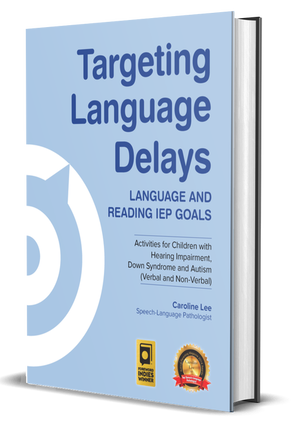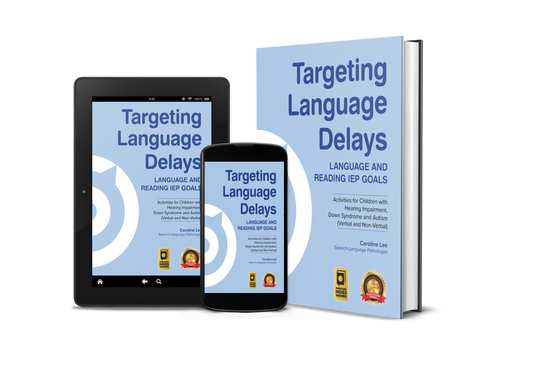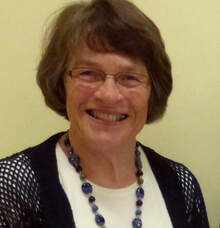ABOUT THE BOOK
Targeting Language Delays
Targeting Language Delays: Language and Reading IEP Goals provides sequential steps in programming to meet more than 100 Individual Education Program/Plan goals in the areas of receptive and expressive language, listening and
whole word reading.
These goals are suitable for verbal and non-verbal children who have communication difficulties in association with development challenges such as Down Syndrome, Autism, neurological delay and hearing loss.
Speech-Language Pathologists, teachers and support personnel will be able to:
• develop an IEP appropriate to the student's language level
• plan and present meaningful therapy sessions
• track individual student's progress using the tracking forms provided
• provide seamless carryover of programming over school years and changes of support personnel
Parents will easily be able to follow the step-by-step instructions in language and reading stimulation enabling them to provide preschool language stimulation or home programming. The carryover activities will complement goals of language therapy, and they will be able to give input into their child's IEP language goals throughout his school career.
Part 1 offers background and tips on teaching language skills and a description of the games referred to in the book.
Part 2 contains goals, activities, games and carryover in key receptive and expressive language areas, as well as printable vocabulary lists and tracking forms.
whole word reading.
These goals are suitable for verbal and non-verbal children who have communication difficulties in association with development challenges such as Down Syndrome, Autism, neurological delay and hearing loss.
Speech-Language Pathologists, teachers and support personnel will be able to:
• develop an IEP appropriate to the student's language level
• plan and present meaningful therapy sessions
• track individual student's progress using the tracking forms provided
• provide seamless carryover of programming over school years and changes of support personnel
Parents will easily be able to follow the step-by-step instructions in language and reading stimulation enabling them to provide preschool language stimulation or home programming. The carryover activities will complement goals of language therapy, and they will be able to give input into their child's IEP language goals throughout his school career.
Part 1 offers background and tips on teaching language skills and a description of the games referred to in the book.
Part 2 contains goals, activities, games and carryover in key receptive and expressive language areas, as well as printable vocabulary lists and tracking forms.
Targeted Goals :
|
• Following directions
• “Yes/no” and negative “no/not” • Vocabulary development (nouns and verbs) • Classification and categorization • Descriptors • Pronouns • “Wh” questions |
• Listening skills (memory and discrimination)
• Word and sentence structure • Same and Different • Concepts • Auditory processing • Advanced expressive language • Whole Word reading |
Each goal is broken down into multiple sequential steps ensuring that underlying skills are targeted before addressing more complex goals.
LANGUAGE THERAPY ALL IN ONE BOOK!
Previously published in 2014 under the title Targeting Language Delays; IEP Goals and Activities for Students with Developmental Challenges. The text is unchanged.
LANGUAGE THERAPY ALL IN ONE BOOK!
Previously published in 2014 under the title Targeting Language Delays; IEP Goals and Activities for Students with Developmental Challenges. The text is unchanged.
Awards
Targeting Language Delays was the Gold Winner in the Education Category in the Indiefab awards for 2014 from Foreword Magazine.
Author Caroline Lee was recognized by Autism Parenting Magazine as one of the top ten writers who contributed to the magazine during 2014.
Author Caroline Lee was recognized by Autism Parenting Magazine as one of the top ten writers who contributed to the magazine during 2014.
Reviews
Journal of Developmental and Behavioral Pediatrics, May 2015, Dr. Tewari Shruti MBBS, MPH. View Full Article Here.
Kim Lewis, M.ED., CCC-SLP, pediatric therapist and the blogger at ActivityTailor.com
“Wow! This is a must-have resource for any pediatric speech therapist! Offering concise goals in a clear hierarchy, it ensures you’ve targeted underlying skills before addressing more complex goals. Therapists will also appreciate the suggestions for treatment activities that align with each individual step.”
“Wow! This is a must-have resource for any pediatric speech therapist! Offering concise goals in a clear hierarchy, it ensures you’ve targeted underlying skills before addressing more complex goals. Therapists will also appreciate the suggestions for treatment activities that align with each individual step.”
Angela Pryor, mother of two boys (13 and 10 years old) one of whom has autism
“An extremely useful resource for both educators and parents that will help our children to learn and use language effectively. A fantastic IEP companion”.
“An extremely useful resource for both educators and parents that will help our children to learn and use language effectively. A fantastic IEP companion”.
EXCERPT
Please note: all chapters in Targeting Language Delays are written in the same format as the following excerpt, except for the final chapter Whole Word Reading Program which is divided into steps for teaching sight words to verbal and to non-verbal students.
Chapter 3 (pp29-38)
Same and Different
Same and Different
These goals are appropriate for students with one or more of the following characteristics:
- is able to match object to object, picture to picture, and object to picture
- has difficulty understanding and using the words “same” and “different”; e.g., horse and horse (same); horse and cow (different)
- is unable to clearly describe features specific to a person, object, or animal
- is developing visual discrimination skills
Same and Different Goals
The student will understand and use “same” and “different” applied to:
Goal 1: identical and non-identical objects (e.g., cup/cup, cup/pen).
Goal 2: objects of the same name that are identical or non-identical by color (e.g., red car/blue car).
Goal 3: the presence or absence of objects in a physical group (e.g., cow/pig/sheep compared with cow/pig/sheep/horse).
Goal 4: objects that have the same name but vary by features other than color (e.g., round/square blocks; striped/spotted pillows).
Goal 5: objects that do not have the same name but have some shared features (e.g., orange and apple; sun and moon).
Goal 6: pictures that vary by one feature.
Goal 7: picture scenes that vary by several features.
The student will understand and use “same” and “different” applied to:
Goal 1: identical and non-identical objects (e.g., cup/cup, cup/pen).
Goal 2: objects of the same name that are identical or non-identical by color (e.g., red car/blue car).
Goal 3: the presence or absence of objects in a physical group (e.g., cow/pig/sheep compared with cow/pig/sheep/horse).
Goal 4: objects that have the same name but vary by features other than color (e.g., round/square blocks; striped/spotted pillows).
Goal 5: objects that do not have the same name but have some shared features (e.g., orange and apple; sun and moon).
Goal 6: pictures that vary by one feature.
Goal 7: picture scenes that vary by several features.
Goal 1: The student will understand and use “same” and “different” applied to identical and non-identical objects (e.g., cup/cup, cup/pen) (with 80–90 percent accuracy).
Prerequisite: Ability to match object to object, object to picture, and picture to picture (not covered in this manual).
Prerequisite: Ability to match object to object, object to picture, and picture to picture (not covered in this manual).
Materials
- 10–20 paired identical toys/objects or pictures of toys/objects; e.g., 2 identical dolls, 2 identical pencils (create non-identical pairs by selecting an object from each of 2 identical pairs).
Introduction
Introduce the goal by telling the student that he is going to learn the words “same” and “different.”
Use some of the paired identical objects or object pictures. Label paired objects that match as the “same” and paired objects that do not match as “different” (e.g., identical toy cars = “same”; toy car and ball = “different”). Describe the reason that they are the same or different (e.g., these are the same—they are both cars; these are different—this is a car and this is a ball). Provide several examples. Give visual support to the student who can read by presenting the written words “same” and “different” on separate cue cards when appropriate and as needed.
Introduce the goal by telling the student that he is going to learn the words “same” and “different.”
Use some of the paired identical objects or object pictures. Label paired objects that match as the “same” and paired objects that do not match as “different” (e.g., identical toy cars = “same”; toy car and ball = “different”). Describe the reason that they are the same or different (e.g., these are the same—they are both cars; these are different—this is a car and this is a ball). Provide several examples. Give visual support to the student who can read by presenting the written words “same” and “different” on separate cue cards when appropriate and as needed.
Activity Receptive
Place 2–6 paired identical toys/objects or toy/object pictures mixed up on the table.
Hold up one object and tell the student to “find same” (e.g., a pencil and an identical pencil).
Hold up any object from the collection and tell the student to find “different” (the student is to show any object other than the matched one (e.g., pencil and car). Ask for “same” and “different” objects randomly.
Note: If the student is having difficulty, work on having him find “same” to 80–90 percent accuracy and then work on “different” to the same level before working on “same” and “different” at random.
Place 2–6 paired identical toys/objects or toy/object pictures mixed up on the table.
Hold up one object and tell the student to “find same” (e.g., a pencil and an identical pencil).
Hold up any object from the collection and tell the student to find “different” (the student is to show any object other than the matched one (e.g., pencil and car). Ask for “same” and “different” objects randomly.
Note: If the student is having difficulty, work on having him find “same” to 80–90 percent accuracy and then work on “different” to the same level before working on “same” and “different” at random.
Activity Expressive
Present pairs of objects (identical and non-identical) and have the student identify them as the same or different (e.g., sock and identical sock = same; hat and mitt = different).
Ask, “How are they different?” Encourage the student to respond using as much of the sentence structure as he is able (e.g., “This one is a car and this one is a ball”). A reduced structure is acceptable at this stage (e.g., “This car this ball”).
Present pairs of objects (identical and non-identical) and have the student identify them as the same or different (e.g., sock and identical sock = same; hat and mitt = different).
Ask, “How are they different?” Encourage the student to respond using as much of the sentence structure as he is able (e.g., “This one is a car and this one is a ball”). A reduced structure is acceptable at this stage (e.g., “This car this ball”).
Carryover
- Play Lotto, Memory, Fishing, Magic Bag, and Go Fish (see section Multipurpose Games in Language Therapy pp. 7-9). Point out and label the cards that are the “same” and those that are “different.”
- Introduce additional vocabulary that expresses the concepts of “same” and “different” (e.g., match, go together).
Following Goal 1, the student will work on Goals 2-6 as described in “Targeting Language Delays” pp31-38 then finish Chapter 3 with:
Goal 7: The student will recognize and describe features that are the “same” and “different” in picture scenes that vary by several features (with 80–90 percent accuracy).
Materials
- Commercial same/different picture scenes showing single and increasing to multiple differences (use clear, uncluttered pictures at first).
Introduction
Tell the student that now he is going to look at pictures that someone else has made and find what is the same and what is different.
Tell the student that now he is going to look at pictures that someone else has made and find what is the same and what is different.
Activity Receptive and Expressive
Use commercial same/different materials, but be careful to start with scenes that are clearly illustrated and contain only one difference. Cartoon characters can be very confusing, so avoid them at first. Have the student gradually work up to searching for multiple similarities and differences.
If necessary, use a piece of cardstock to cover irrelevant parts of the picture and highlight the area in which the student is to look.
Use commercial same/different materials, but be careful to start with scenes that are clearly illustrated and contain only one difference. Cartoon characters can be very confusing, so avoid them at first. Have the student gradually work up to searching for multiple similarities and differences.
If necessary, use a piece of cardstock to cover irrelevant parts of the picture and highlight the area in which the student is to look.
Carryover
- Have 2 typically developing students draw a picture of the same object or scene (e.g., car, house, playground, beach). Compare and discuss with your student how the pictures are the same and different.
- Take photos at different times of places and scenes familiar to the student. Compare and discuss them (e.g., trees in summer and fall; playground at recess and after school; tidy desk/untidy desk).
- Play computer games or use apps that require the student to find two or more differences in designs and pictures.
Purchase Your Copy of Targeting Language Delays
1. FREE Pdf Version
Contact the author for your free PDF by emailing:
[email protected]
2. Purchase eBook
Can be read by all devices including eReaders
3. Purchase Print Version
By emailing:
[email protected]
Some print versions may still be available through Amazon.ca or Amazon.com or other on-line book sellers.
ABOUT THE AUTHOR
Caroline Lee
Over her career, Caroline Lee worked with children in public health, school boards
and private practice. During seventeen years with a school board in Ontario, she
carried out assessments and planned programming for students with a broad
range of speech/language delays and developmental challenges including those
with Down Syndrome, hearing loss, and on the autism spectrum. While supervising
the implementation of programming through support personnel she felt the need
of a book that could be referenced by those providing programming. Following
retirement from practice, Caroline wrote the book that she wished she had had on
her desk all along!
and private practice. During seventeen years with a school board in Ontario, she
carried out assessments and planned programming for students with a broad
range of speech/language delays and developmental challenges including those
with Down Syndrome, hearing loss, and on the autism spectrum. While supervising
the implementation of programming through support personnel she felt the need
of a book that could be referenced by those providing programming. Following
retirement from practice, Caroline wrote the book that she wished she had had on
her desk all along!
Get In Touch
For questions, reviews, and media enquiries, please submit your details below and I will get back to you shortly.
Thank you!
Thank you!




